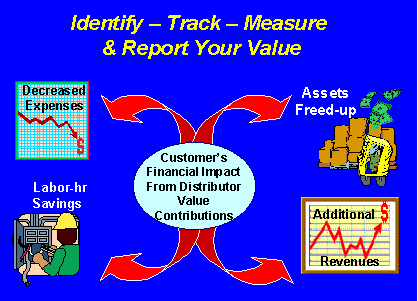|
|
|
Step 6: Measure and Report Your Value Contributions An important post-sale component of your value proposition is a logical system to identify, track, measure, and report your extended value contributions to customers. By quantifying and communicating your value in credible terms, you provide your customers with a valuable business tool for internal planning and performance improvement efforts. Concurrently, this ongoing activity re-emphasizes your tangible worth as a high-value supplier. Despite the persuasive reasons for measuring and communicating their value contributions to customers, a recent study found that 3 out of 4 distributors don't do it!
The four basic areas where distributors can financially impact their customers are shown in the slide below:

Once delivered, every distributor value [contribution] impacts one or more of the customer's financial measures shown above. However, successfully quantifying the financial impact depends on the availability or estimation of many types of information variables such as:
|
- Purchased materials volumes
|
- Revenue per production unit
|
- Labor-hr costs and quantities
|
- Purchased materials costs
|
- Overhead and administrative costs
|
- Inventory quantity and value
|
- Production downtime costs
|
|
- Outsourced services costs
|
- Inventory/asset carry cost %
|
- Maintenance and repair costs
|
- Distributor solution fees
|
|
This kind of data can be obtained from distributor records, customer records, industry benchmarks, and through estimates. Customer input is preferable and most readily accepted in value calculations, but it is usually more conservative, too. Reasonable estimates are certainly an alternative if other information resources fail, but take care to back them up with your assumptions and sources used. When in doubt about the credibility of any value contribution calculation, review and confirm your approach and assumptions with your customer.
Value Contribution/Measurement Matrix Simplifies Reporting
Once you have collected the relevant data to quantify your distributor value, you are ready to perform the appropriate calculations to record and present your results to your customer. We have developed a matrix relating each potential extended value contribution to one or more sets of typical measurement options. These calculation methods may be used to quantify any of the customer impact areas shown in the slide above. For distributors that are actively involved with measuring and reporting their extended value services, there are also automated methods available to simplify the calculation and reporting activity for customers.
|
|
[top of page]
|
|
We have extensive experience in developing systems for measuring and reporting distributor value contributions. Let us help you streamline and simplify your value reporting process. Please call us today at 704-232-6858. |
